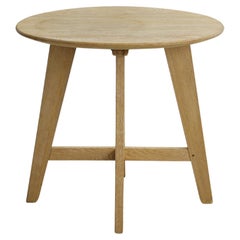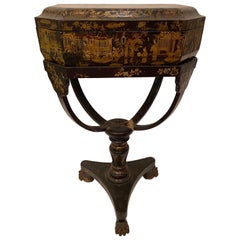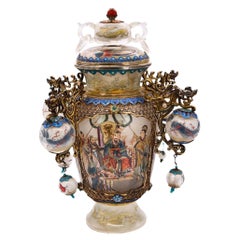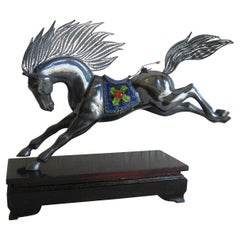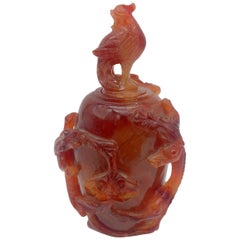East Asian Antiquities
to
334
565
288
1,315
13
5
4
3
2
2
1
1
1
1
480
409
426
18
212
46
61
23
3
9
3
3
4
7
6
15
2
562
294
284
248
157
1,879
1,333
741
387
379
1,333
1,330
1,330
10
3
3
2
1
Place of Origin: East Asian
Japanese Antique Table, Early 20th Century
Located in Katori-Shi, 12
This is a compact round table that flares out at the end.
It has tapered legs that become thinner towards the base, giving it a delicate and elegant appearance despite its neat, una...
Category
Early 20th Century Taisho East Asian Antiquities
Materials
Wood
Antique 19th Century Chinese Lacquer Sewing Box with the Stand
Located in Brea, CA
Antique 19th century Chinese lacquer sewing table with hand painted scenes and beautiful legs. Gilt export black lacquer all-over the tabl...
Category
Mid-19th Century Qing Antique East Asian Antiquities
Materials
Lacquer
China Republic 1912-1960 Inside Paint Carved Rock Crystal Vase Silver & Enamel
Located in Miami, FL
An impressive China inside-painted vase in rock crystal.
Beautiful and one-of-a-kind art-piece. created in China during the first years of the China-republic, circa 1912-1949. Thi...
Category
1940s Chinese Export Vintage East Asian Antiquities
Materials
Multi-gemstone, Rock Crystal, Silver, Sterling Silver, Enamel
$14,887 Sale Price / set
25% Off
6 Elegant Ming Dynasty Court Attendants in Glazed Terracotta, China 1368-1644 AD
Located in San Pedro Garza Garcia, Nuevo Leon
A fine set of a six court attendants as in the Forbidden City of Beijing, elegantly dressed in a Green & Red Daopao – a traditional men’s formal attire from the Ming Dynasty dated 1368-1643 A.D. – with glazed robes and Red Pigment remains in their hat and belts. They stand in an honorary posture atop a red plinth, some with orifices in their hands, where spirit objects were placed to comfort or satisfy the deceased. The heads are detachable, as often seen on the larger figures from this period.
They are accompanied by a Certificate of Authenticity, and Certificate of Expertise by Jean-Yves Nathan - a leading authority specialized in Far East Archaeology from the CEDEA (The European Confederation of Art Experts).
Burial figurines of graceful dancers, mystical beasts, and everyday objects reveal both how people in early China approached death and how they lived. Since people viewed the afterlife as an extension of worldly life, these figurines, called mingqi, sometimes referred as “spirit utensils” or “vessels of ghosts” disclose details of routine existence and provide insights into belief systems over a thousand-year period.
The Ming dynasty was the ruling dynasty of China – then known as the Empire of the Great Ming – for 276 years (1368–1644 AD). Founded by Chu Yuan-chang, the rebel leader that was successful in removing the mongols from the throne. Chinese control was re-asserted in China and eastern Asia. Literature became more important, schools were created, and the justice system was reformed. The Ming dynasty is described by some as "one of the greatest eras of orderly government and social stability in human history,” was the last imperial dynasty in China ruled by ethnic Han Chinese.
The practice of burying ceramic objects with the deceased went into decline from the 10th to the 14th Century AD. There was a revival in placing miniature representations of glazed terracotta objects such a furniture, food offerings, horses, miniature statues...
Category
15th Century and Earlier Ming Antique East Asian Antiquities
Materials
Terracotta
Fine Antique Chinese Sterling Silver and Enamel with Coral Beads Horse Sculpture
Located in San Diego, CA
Fine antique Chinese sterling silver and enamel horse sculpture mounted on a lacquered wood stand. The horse is made of sterling silver...
Category
Early 20th Century East Asian Antiquities
Materials
Sterling Silver
19th Century Antique Chinese Agate Bottle
Located in Brea, CA
Antique 19th century Chinese agate bottle with lid with Chi dragons, decorated in the form , see more pictures diameter 7.5 cm, high 14 cm.
Category
Late 19th Century Qing Antique East Asian Antiquities
Materials
Agate
Small Qingbai Pear-Shaped Vase, Song-Yuan Dynasty(13-14th century)
Located in seoul, KR
This exquisite piece is a Qingbai ware from the Song to Yuan dynasty, and it appears to be an excavated artifact given its earthy encrustations, suggesting it has rested in the groun...
Category
15th Century and Earlier Antique East Asian Antiquities
Materials
Ceramic, Porcelain
$895 Sale Price
50% Off
18th Century Chinese Lacquer Bowl with Pewter
Located in Brea, CA
Chinese lacquer bowl of deep flared form with pewter from the 18th century. Over a body of black lacquered the exterior decorated with gilt scenes o...
Category
18th Century Qing Antique East Asian Antiquities
Materials
Lacquer
Superb Set of 5 Elegant Court Attendants, Ming Dynasty, 1368-1644 AD TL Tested
Located in San Pedro Garza Garcia, Nuevo Leon
A stunning set of 5 graceful terracotta figurines from the Ming Dynasty '1368-1644' AD. These elegant attendants are standing on a yellow glazed lotus flower over a high hexagonal green plinth and wear fine robes in matching green and yellow glazes. The unglazed areas have pigmented colors in red, black and white. Each is carrying essential offerings for the royal family. The head is detachable as often seen on the larger figures from this period. Meticulously detailed facial expressions have been hand-painted.
Condition: Mint, finely preserved glaze and pigment, undamaged and no repairs.
Provenance: Ex. Danish Collection.
This set is guaranteed authentic and comes with a Certificate of Authenticity and TL Test from Laboratory Kotalla in Germany (The Oldest Thermoluminescence Testing Laboratory in the World).
Dimensions: Average 54 H cms
Burial figurines of graceful dancers, mystical beasts, and everyday objects reveal both how people in early China approached death and how they lived. Since people viewed the afterlife as an extension of worldly life, these figurines, called mingqi, sometimes referred as “spirit utensils” or “vessels of ghosts” disclose details of routine existence and provide insights into belief systems over a thousand-year period.
The Ming dynasty was the ruling dynasty of China – then known as the Empire of the Great Ming – for 276 years (1368–1644 AD). Founded by Chu Yuan-chang, the rebel leader that was successful in removing the mongols from the throne. Chinese control was re-asserted in China and eastern Asia. Literature became more important, schools were created, and the justice system was reformed. The Ming dynasty is described by some as "one of the greatest eras of orderly government and social stability in human history,” was the last imperial dynasty in China ruled by ethnic Han Chinese.
The practice of burying ceramic objects with the deceased went into decline from the 10th to the 14th Century AD. There was a revival in placing miniature representations of glazed terracotta objects such a furniture, food offerings, horses, miniature statues...
Category
15th Century and Earlier Ming Antique East Asian Antiquities
Materials
Terracotta
Han Cocoon Shaped Vessel
Located in Coral Gables, FL
Han dynasty, China, circa 200 BC to 2 AD.
Category
15th Century and Earlier Other Antique East Asian Antiquities
Materials
Earthenware
$5,000
Han Dynasty, Antique Chinese Painted Pottery Cocoon Jar
Located in Sampantawong, TH
Antique Chinese painted pottery cocoon jar with original pigments remaining.
The cocoon jar is sometimes called a "duck-egg jar", used as a wine vessel during Han Dynasty.
Age: Ch...
Category
15th Century and Earlier Antique East Asian Antiquities
Materials
Pottery
Green-Glazed Pottery Elephant, Han dynasty
Located in seoul, KR
This piece is an elephant statue made of green-glazed pottery. During the Han Dynasty, artworks depicting elephants were quite rare. However, such representations did occasionally appear. For example, the bronze vessel from the Han Dynasty housed in the Shanghai Museum is one of the notable examples of this type of craftsmanship. The existence of elephants in ancient China is attested both by archaeological evidence and by depictions in Chinese artwork. Long thought to belong to an extinct subspecies of the Asian elephant named Elephas maximus...
Category
15th Century and Earlier Han Antique East Asian Antiquities
Materials
Pottery
$3,742 Sale Price
25% Off
Japanese Antique Bamboo basket Folk art Wabi-Sabi
Located in Chiba, Chiba
This bamboo basket is made by combining bamboo of various shapes.
It is a folk craft item made by hand by people in the past.
It is made of bamboo so it is very lightweight.
The bamb...
Category
Early 20th Century East Asian Antiquities
Materials
Bamboo
Japan Good Luck Elephant Censer
Located in West Hollywood, CA
This charming censer features an elephant, a symbol of strength, wisdom, and good fortune in Japanese culture. The elephant's back opens to hold incens...
Category
Early 20th Century East Asian Antiquities
Materials
Bronze
Japanese Antique Wooden Bowl 1910s-1940s Primitive Wabi-Sabi
Located in Chiba, Chiba
This is a Japanese wooden bowl.
It is a folk craft that was used in daily life.
I don't know what kind of wood it's made of, but it's sturdy.
Since it is made by hand, it has a dist...
Category
Early 20th Century East Asian Antiquities
Materials
Wood
$300 Sale Price
40% Off
19th Century Huanghuali Chinese Opium Scale
Located in Atlanta, GA
Beautifully carved scale box from the much desired Huanghuali wood.
These scales were originally used to weigh herbs, medicines, and precious metals, but are known as opium scales...
Category
Late 19th Century Antique East Asian Antiquities
Materials
Brass
Pair of Chinese Porcelain Cover Jars, 19th Century
Located in New York, NY
multicolor floral motif
Category
Mid-19th Century Antique East Asian Antiquities
Materials
Porcelain
A Russet-Splashed Blackish-Brown-Glazed Jar, Song Dynasty
Located in seoul, KR
Lustrous blackish-brown glaze decorated on the exterior with lines of splashes of russet color. This jar features a rounded and voluminous body, with its shoulders gently curving upward to meet the lid. The lid is topped with a small knob-like handle at the center, creating a harmonious and well-balanced overall proportion.
Under microscopic magnification, the brown-glazed...
Category
15th Century and Earlier Antique East Asian Antiquities
Materials
Ceramic
$8,775 Sale Price
35% Off
A Rare Sancai-Glazed Pottery Jar, Tang Dynasty
Located in seoul, KR
The jar is of globular shape and is decorated to the body with a geometric design band of lozenge-shaped motifs in blue, green, ochre and cream below a plain ochre everted mouth rim,...
Category
15th Century and Earlier Tang Antique East Asian Antiquities
Materials
Earthenware
$7,950 Sale Price
50% Off
Pair of Chinese Blue & White Porcelain Cover Vases, 19th Century
Located in New York, NY
cherry blossom motif
Category
Mid-19th Century Antique East Asian Antiquities
Materials
Porcelain
Lang Yao Water Coupe, Qing Period
Located in seoul, KR
This ceramic piece features a low, rounded form with a narrow mouth, exemplifying refined simplicity and balance. The surface is covered in a rich, deep crimson glaze, likely derived...
Category
18th Century Qing Antique East Asian Antiquities
Materials
Ceramic
$1,500 Sale Price
25% Off
Antique Iwayaki Earthenware Edo Incense Burner of a Turtle 19th Century Japan, J
Located in Amsterdam, Noord Holland
Nicely made and large incense burner or Okimono of a turtle. In earthenware with nice patina. Shimane Prefecture Iwayaki (Nagahama Yaki) Turtle figurine. The head and part of the bac...
Category
19th Century Edo Antique East Asian Antiquities
Materials
Earthenware
$2,758 Sale Price
20% Off
19th Century Chinese Porcelain Dish
Located in Brea, CA
19th century Chinese porcelain dish with beautiful hand painted. Diameter 12.4 inch, with a mark.
Category
Late 19th Century Chinese Export Antique East Asian Antiquities
Materials
Porcelain
Rare Boshan Incense Burner Yue Celadon, Jin dynasty
Located in seoul, KR
The Boshan incense burner is particularly notable among Han dynasty incense burners for its unique shape. Designed to resemble a mountain or even a mythical mountain, it is characterized by its pointed peaks that rise upwards. These peaks often function as vents for the smoke, creating an effect reminiscent of a volcanic eruption.
The body of the incense burner is typically round, with multiple small peaks surrounding a central, larger peak. The material used is mainly ceramic, although there are instances where they were made of bronze. It is presumed that this incense burner was used for religious or ceremonial purposes during its time. The colors of these burners are usually in shades of pale green or greyish brown, with the application of glaze to achieve a variety of colors on occasion.
Such incense burners are often found in tombs or ritual sites, and their purpose was to burn incense for purification of space or to produce pleasant aromas. The Boshan incense burner also represents a significant cultural heritage, showcasing the craftsmanship and artistic values of the period. Today, it is considered a quintessential example of ancient Chinese art.
Period : Han-Jin Dynasty
Type : Incense Burner
Medium : Yue celadon...
Category
15th Century and Earlier Han Antique East Asian Antiquities
Materials
Stoneware
$5,960 Sale Price
60% Off
Chinese Lotus Mooncake Mold, c. 1900
Located in Chicago, IL
This 19th-century hand-held wood press is carved with a large mold used for shaping festive mooncakes. Packed with lotus root, red bean, or other regional fillings, mooncakes are a d...
Category
Early 20th Century Qing East Asian Antiquities
Materials
Wood
Rare Blue and Red-Copper Peacock Yuan Dinesty
Located in Newmanstown, PA
Rare Blue and Red-Copper Dish Yuan Dynasty Painted to the interior with a peacock in a lively garden and seal mark, repeated on exterior. Height: 2.5 in, Width: 16.5 in, Base Width: 10.25 in
During the Yuan dynasty (1271-1368), blue and white porcelain developed in Jingdezhen of Jiangxi province became increasingly popular, earning Jingdezhen the recognition of China’s ceramic metropolis. The cobalt ore used in the blue pigment for Yuan dynasty blue-and-white wares were originally imported from Persia. While a formative influence in Yuan blue...
Category
15th Century and Earlier Antique East Asian Antiquities
Materials
Porcelain
Pair of Qingbai Vases, Song-Yuan Dynasty
Located in seoul, KR
This pair of Qingbai vases features a soft bluish-green glaze with elegant, fluted bodies and wide, flared rims. The vases are hand-crafted, with subtle differences that highlight th...
Category
15th Century and Earlier Antique East Asian Antiquities
Materials
Porcelain
$2,183 Sale Price / set
44% Off
Chinese Neolithic Qijia Culture Red Pottery Vessel, 2200 BC - 1600 BC, China
Located in Austin, TX
An attractive Neolithic Chinese burnished red pottery vessel, Qijia Culture (2200 BC - 1600 BC), modern day Gansu Province, China.
The vessel of compressed globular form set on a short, pieced pedestal foot, and featuring two ear handles, a short, wide neck, and slightly everted mouth. A simple incised band decorates the otherwise plain body.
The red pottery with a beautiful rich terracotta hue. The slight burnishing makes the vessel glow.
The Qijia Culture was a late Neolithic...
Category
15th Century and Earlier Antique East Asian Antiquities
Materials
Pottery
Pair of Chinese Porcelain Vases, 19th c.
Located in New York, NY
decorated with a multicolor figural scene
Category
Mid-19th Century Antique East Asian Antiquities
Materials
Porcelain
$1,500 / set
Chinese robin's egg glazed porcelain water pot, 19th c.
Located in New York, NY
in the form of a butterfly
Category
Early 19th Century Antique East Asian Antiquities
Materials
Porcelain
Amber-Glazed Pottery Figure of Dog, Tang-Liao Dynasty (7-12th Century)
Located in seoul, KR
A Dog sitting on his haunches, covered in an amber glaze. Naturalistically modeled, the figure follows the artistic style of the period. It remains uncertain whether the glaze has wo...
Category
15th Century and Earlier Tang Antique East Asian Antiquities
Materials
Pottery
$1,943 Sale Price
35% Off
Chinese Decorative Wall Plate with Butterflies
Located in Milano, IT
Round plate made of bronze and cloisonné enamel designed in China in the 20th century.
This dish is made of bronze and cloisonné enamel, a goldsmith's technique originally applied to jewellery design. The polychrome decorations depict a circular geometric pattern, with blue and white butterflies...
Category
20th Century Chinese Export East Asian Antiquities
Materials
Bronze
$761 Sale Price
20% Off
Two Green glazed Figures Holding Pitchpork, Han dynasty
Located in seoul, KR
Han dynasty pottery tomb figure, modelled standing holding a Pitchpork in front of his body, covered in a turquoise-green glaze. These two pieces are believed to have been produced i...
Category
15th Century and Earlier Han Antique East Asian Antiquities
Materials
Pottery
$2,227 Sale Price / set
25% Off
pair of Chinese porcelain cover vases, 19th c.
Located in New York, NY
floral motif; 10in is the height of each cover vase including the base
Category
Late 19th Century Antique East Asian Antiquities
Materials
Porcelain
$2,400 / set
Neolithic Pottery Amphora(Gansu Province), 3rd-2nd Millenium BC
Located in seoul, KR
Neolithic Jar with strap handle from Gansu Province. Acquired in Hong Kong in the late 1990s.
Date : 3,000-2,000 BC
Made in : Gansu province
Dimension : 23cm (Height) x 8.5cm(Mouth ...
Category
15th Century and Earlier Antique East Asian Antiquities
Materials
Earthenware, Pottery
$2,275 Sale Price
35% Off
Small Celadon Chrysanthemum Dish, Northern Song Dynasty(AD 960~1127)
Located in seoul, KR
Potted with the fluted sides rising from a recessed base, carved to the interior with Chrysanthemum, covered overall with a grayish-green glaze, save for a ring to the underside left unglazed to reveal the gray stoneware...
Category
15th Century and Earlier Ming Antique East Asian Antiquities
Materials
Celadon
$3,185 Sale Price
35% Off
Unusual and Very Rare Edo Period Brazier Hook in Keyaki Wood, 19th Century
Located in Fukuoka, JP
A remarkable and rare find from the Edo–Meiji transition period, this large wooden brazier hook (jizaikagi) was traditionally used in wealthy farmhouse interiors, suspended from the ...
Category
19th Century Edo Antique East Asian Antiquities
Materials
Wood
Chinese turquoise glazed porcelain water pot, 19th c.
Located in New York, NY
crackle decorated
Category
Mid-19th Century Antique East Asian Antiquities
Materials
Porcelain
Burl wood Display Stand with Beautiful Grai / Shikiita stand / tea ceremony tray
Located in Fukuoka, JP
This elegant Japanese shikiita stand is crafted from richly patinated burl wood, showcasing a mesmerizing natural grain pattern across its surface. Traditionally used in Japanese int...
Category
20th Century Showa East Asian Antiquities
Materials
Wood, Burl
A Cizhou Blackish Brown Glazed Stoneware Foliate Jar, Northern Song Dynasty
Located in seoul, KR
The jar is covered with a deep, warm blackish-brown glaze. The glaze is smooth and even, with a soft sheen.
The foliate rim has a gentle, wave-like design that gives the jar a natur...
Category
15th Century and Earlier Antique East Asian Antiquities
Materials
Stoneware
$2,600 Sale Price
35% Off
Chinese Yellow Peking Glass Vase, 19th Century
Located in New York, NY
provenance: Christie's auction house
Category
Early 19th Century Antique East Asian Antiquities
Materials
Glass
19th Century a Pair of Chinese Silk Fans with Giltwood Handles
Located in Brea, CA
Antique 19th century hand painted floral motifs on silk Chinese fans Qing dynasty, the fan in silk with silk fringe and giltwood handles, housed within a conforming paper covered box...
Category
Late 19th Century Qing Antique East Asian Antiquities
Materials
Silk
18th Century Chinese Lacquer Mother of Pearl Inlay Pewter Teapot
Located in Brea, CA
18th century Chinese lacquer mother of pearl inlay pewter teapot, height to handle top 8 inch, floral decoration as expected for age an...
Category
Early 18th Century Chinoiserie Antique East Asian Antiquities
Materials
Mother-of-Pearl
Antique Chinese Multi-Lobed Opium Box in Silver, Decorated with Reliefs with Ide
Located in Leuven , BE
Beautiful opium box decorated with reliefs with ideograms (one of the two refers to wealth), a chrysanthemum (symbol of longevity) and foliage. This silver m...
Category
19th Century Antique East Asian Antiquities
Materials
Silver
Japanese Porcelain Sake Cup Ochoko Leaves 1960s Kutani ware
Located in Paris, FR
This is a small cup for drinking sake. It is called Ochoko in Japanese.
It was made in showa era around 1960s. It is made with porcelain and all hand painted.
This is Kutani ware.
...
Category
1960s Showa Vintage East Asian Antiquities
Materials
Porcelain
Three Glazed Figures of Musicians, Ming Period (1368-1644)
Located in seoul, KR
Statues of Chinese musicians crafted from terracotta, featuring glazes in green, blue with nice condition. Set on rectangular bases. Compared to other figures, musician figures are relatively rare, two figures with distinctive instrument from that era.
Period: Ming Dynasty
Medium: Green and Blue glazed Pottery
Type: Figure
Provenance : Acquired in early 2000s from Hongkong
Reference :
1) V&A Museum - Accession number C.1501913
(Type : Closely related)
* Ming Dynasty Glazed Pottery Figures
Ming Dynasty glazed pottery figures are renowned for their bold color palette, intricate detailing, and lifelike forms, distinguishing them from earlier traditions. These figures, which depict officials, warriors, animals, and mythical creatures, are characterized by high-gloss lead-based glazes in green, amber, ochre, and sancai (three-color) combinations. The thickly applied glaze pools in recesses, creating depth and enhancing sculptural details. With dynamic postures, expressive facial features, and meticulously rendered drapery, these figures reflect the period’s advancement in ceramic craftsmanship, offering a greater sense of movement and realism compared to the rigid and stylized forms of earlier dynasties.
A defining characteristic of Ming glazed pottery is its elaborate surface detailing, often achieved through raised relief elements and contrasting glazes. Equestrian figures, for example, feature carefully sculpted saddles, harnesses, and decorative embellishments, while human figures are adorned with intricate robes and headdresses. The large scale of these tomb figures, often more imposing than those from previous periods, underscores the increasing importance of funerary art during the Ming era. Unlike later Qing Dynasty figures...
Category
15th Century and Earlier Ming Antique East Asian Antiquities
Materials
Pottery
$1,943 Sale Price / set
35% Off
Antique Pair of Chinese Blue and White Porcelain Bowls
Located in Brea, CA
a pair of antique Chinese blue and white porcelain bowls with very beautiful hand paint. There are double blue circles at the bo...
Category
Early 20th Century Qing East Asian Antiquities
Materials
Porcelain
Early 20th Century Japanese Jewelry Box
Located in Dallas, TX
This early 20th century Japanese jewelry box is made of black lacquer and decorated with beautiful floral detailing. This piece sti...
Category
Early 20th Century East Asian Antiquities
19th Century Pair of Chinese Porcelain Fruit Dishes
Located in Brea, CA
19th century a pair of large Chinese porcelain fruit dishes with beautiful hand painted. Measures: 8.5 x 6.25 x 2 inch.
Category
Late 19th Century Chinese Export Antique East Asian Antiquities
Materials
Porcelain
19th Century Blue and White Japanese Porcelain Dish Meiji Period
Located in Brea, CA
19th century blue and white Japanese porcelain dish Meiji period decorated with prunus on the cobalt blue ground, inscription to base, Ex Bonhams lot 268 diameter 12 inch.
Category
Late 19th Century Japonisme Antique East Asian Antiquities
Materials
Porcelain
19th Century Shell Inlaid Black Lacquer Big Chinese Chest Labled "Sunshing"
Located in Brea, CA
19th Century Shell Inlaid Black Lacquer Big Export Chinese Chest Labled inside "Sunshing" and with Bail handles to sides ,14.5 inch long /10.5inch width/11.5 high inch,big chest...
Category
Late 19th Century Qing Antique East Asian Antiquities
Materials
Lacquer
Large Handpainted Asian parasol on rice paper - Chinese cranes and bambo Ø 215cm
Located in Linkebeek, BE
Handpainted Asian parasol on rice paper - Chinese cranes and bambo Ø 215cm - Gabriella Savoye Signed
Asian decoration - Vintage - Feng Shui
Measures : Ø 215cm H215cm
Material : Bamb...
Category
20th Century East Asian Antiquities
Materials
Bamboo, Paper
Green-Glazed Pottery ‘Money Tree’ Base, Han Dynasty
Located in seoul, KR
This piece, directly referred to as a Money Tree, is a captivating work that embodies wishes for material prosperity. It takes center stage in the Asian collections of institutions s...
Category
15th Century and Earlier Han Antique East Asian Antiquities
Materials
Earthenware, Pottery
$19,500 Sale Price
35% Off
Green-glazed Pottery Amphora with Brown glazed Phoenix, Tang-Liao Dynasty
Located in seoul, KR
The vessel has an overall oval shape, characterized by smooth curves that transition naturally from the rim to the body. The upper part of the jar narrows slightly, with four handles...
Category
15th Century and Earlier Tang Antique East Asian Antiquities
Materials
Pottery
$9,540 Sale Price
40% Off
Chinese Tibetan bronze Buddha, 18th c.
Located in New York, NY
one hand is shown holding an ornament, and the other hand is in a typical Buddhist pose
Category
Mid-18th Century Antique East Asian Antiquities
Materials
Bronze
Green and Ochre Glazed Altar Table with Offerings, Ming Dynasty, 15~16th Century
Located in seoul, KR
The table bearing pig head, rice cakes, dishes of meat, fish and fruit. Known as Mingqi, these terracotta models were customarily included in Chinese burial practices, particularly among the affluent, to aid the deceased in their journey through the afterlife. This tradition extends back to the Neolithic Period. A unique terracotta funeral table...
Category
15th Century and Earlier Ming Antique East Asian Antiquities
Materials
Pottery
$2,730 Sale Price
30% Off
Green-glazed pottery tripod 'hill' jar, Han Dynasty, 206 BC - 220 AD
Located in seoul, KR
The modelled animal figures and landscapes of this piece represent the Daoist ideology of the Han dynasty. The mountain-shaped lid refers to the sacred dwellings of the immortals, th...
Category
15th Century and Earlier Han Antique East Asian Antiquities
Materials
Stoneware
$2,242 Sale Price
25% Off
Japanese Antique Black Cabinets, Wabi-Sabi, Early 20th Century
Located in Katori-Shi, 12
This is a Japanese antique furniture made in the Taisho period (1912-1926).
It has four drawers with copper handles from that time.
The base of the handles is decorated with a typic...
Category
Early 20th Century Taisho East Asian Antiquities
Materials
Wood
White Ware with two dragons, Yuan Dynasty, 13-14th century
Located in seoul, KR
This vase is made from a type of low-fired, porous clay and features a crackled glaze. It bears resemblance to the renowned funerary vases and covers adorned with applied decorations...
Category
15th Century and Earlier Antique East Asian Antiquities
Materials
Ceramic, Porcelain
$1,245 Sale Price
50% Off
Antique plate Qianlong with floral decor and kintsugi
Located in MEAUX, FR
One Famille rose plate with the mark of “Qianlong nian zhi.
Beatifully handpainted theme of different flowers of peony, lotus , etc, and goldfishes, meaning Prosperity and well-be...
Category
18th Century Antique East Asian Antiquities
Materials
Gold
Recently Viewed
View AllMore Ways To Browse
Large Chinese Celadon Pots
Khmer Torso
Ancient Luristan Bronze
Chinese Terracotta Army Warriors
Cloisonne Pots Bonsai Trees
Greco Bactrian
Han Dynasty Amphora
Han Dynasty Court Lady
Palanquin Handles
Sancai Phoenix
Schist Gandharan Buddha
Bactrian Stone
Chinese Coconut Cup
Han Dynasty Chinese Cocoon Jar
Han Dynasty Cocoon Jars
Han Dynasty Pig
Khmer Goddess
Kojima Shoten
